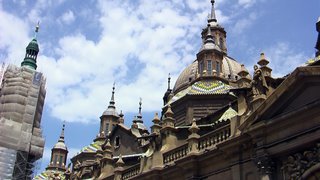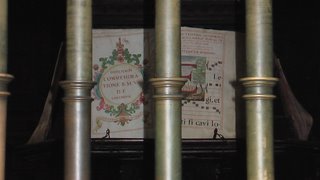 If my favorite place in all of Spain was the "conversion room" in the Loyola family home (coming in another two or three travel posts!), Barbara's was Zaragosa's co-cathedral of Our Lady of the Pillar. That was our next destination, even though we only had a couple of hours to spare for it if we were ever going to get to the Xavier castle! First, however, we had to get there. That meant driving through a desert with dry, shale mountains stubbled with shrubs and scrub. The overall impression was one of gravel, or of whites sands like Los Alamos. And yet in between these expanses are fields of lovely wheat! Since Barbara had done a lot of research here for her screenplay, she filled us in on the history. Apparently, during the Spanish Civil War, the two sides (neither of which had the resources to win) aligned themselves with two larger, European powers. Unfortunately, those powers were the Nazis and the Soviets, neither of whom had any abiding interest in Spain's future, but both of whom had designs on the rest of Europe. So they used the dry plains of Aragon for target practice, preparing for the aerial technologies that WWII would "need." Villages were reduced to the piles of rubble we saw here and there. Big piles of dry, stony rubble, often with a church incongruously visible. Barbara said that after the war, Franco attempted to bring back the past by having the churches rebuilt, even if the town wasn't. And even in the great churches that were restored, you can tell the difference in workmanship between the medieval and later forms and local styles (which are very distinctive) and their rather clumsy modern replacements.
If my favorite place in all of Spain was the "conversion room" in the Loyola family home (coming in another two or three travel posts!), Barbara's was Zaragosa's co-cathedral of Our Lady of the Pillar. That was our next destination, even though we only had a couple of hours to spare for it if we were ever going to get to the Xavier castle! First, however, we had to get there. That meant driving through a desert with dry, shale mountains stubbled with shrubs and scrub. The overall impression was one of gravel, or of whites sands like Los Alamos. And yet in between these expanses are fields of lovely wheat! Since Barbara had done a lot of research here for her screenplay, she filled us in on the history. Apparently, during the Spanish Civil War, the two sides (neither of which had the resources to win) aligned themselves with two larger, European powers. Unfortunately, those powers were the Nazis and the Soviets, neither of whom had any abiding interest in Spain's future, but both of whom had designs on the rest of Europe. So they used the dry plains of Aragon for target practice, preparing for the aerial technologies that WWII would "need." Villages were reduced to the piles of rubble we saw here and there. Big piles of dry, stony rubble, often with a church incongruously visible. Barbara said that after the war, Franco attempted to bring back the past by having the churches rebuilt, even if the town wasn't. And even in the great churches that were restored, you can tell the difference in workmanship between the medieval and later forms and local styles (which are very distinctive) and their rather clumsy modern replacements.Anyway, we spent a long time in the desert, and finally, the oasis of Zaragosa appeared, and the towering silhouette of Our Lady of the Pillar. Barbara started absolutely squirming with excitement. We arranged to meet the driver in two or three hours (he went to get directions to the Xavier castle in Navarre), and headed across the cobblestones of the plaza towards Our Lady's shrine with its remarkable multi-colored tile roof. As we went, Karen unclipped her camera bag and reached for the exquisite camera which...fell to the ground with a heavy thump. Ugh. Hoping for a miracle, Karen gave the shutter a try, but (this being a digital camera) all she got was an error message. There was nothing we could do--and we hadn't even reached the Basque region (Pais Vasco) yet! Well, our Lady was right there, so we traipsed over the stones of the plaza. That's where I basically lost Barbara and Karen for over an hour, to the point where I became very nervous. Turns out they were in the gift shop. (If you can't shoot, shop!) Well, I had taken a ton of pictures, hoping for the best, since the church was so large. I aimed my
 camera at the Virgin of the Pillar, at the bombs the Nazis sent into that very church (full of their prisoners)-the bombs that bounced on the marble floors and are now hanging, like victory tokens, on either side of our Lady's central shrine, at the immense organ and music book, at the three-story high alabaster reredo. I prayed, I kissed the pillar (where Mary is devoutly believed to have appeared to a discouraged Apostle James), I wondered if I would ever see Barbara or Karen again. This was one church that was spared desecration by its own people: none of its side altars were stripped bare; no poorly executed painting or large but tasteless 20th century statues filling (or trying to fill) the side chapels.
camera at the Virgin of the Pillar, at the bombs the Nazis sent into that very church (full of their prisoners)-the bombs that bounced on the marble floors and are now hanging, like victory tokens, on either side of our Lady's central shrine, at the immense organ and music book, at the three-story high alabaster reredo. I prayed, I kissed the pillar (where Mary is devoutly believed to have appeared to a discouraged Apostle James), I wondered if I would ever see Barbara or Karen again. This was one church that was spared desecration by its own people: none of its side altars were stripped bare; no poorly executed painting or large but tasteless 20th century statues filling (or trying to fill) the side chapels.When Karen and Barbara reappeared with their shopping bags, we headed to a small restaurant for lunch. The place we chose had outdoor seating and was evidently located above or very near some ancient Roman ruins. Our cheerful (and somewhat insolent) waiter made recommendations that we were happy to accept; Karen stuck by her decision to have paella everywhere. And we had a bit of an encounter with a gypsy girl (and baby) who took advantage of our exposed position. I have to admit having a very hard time being able to name anything particularly positive about the gypsy culture. It seems so abusive toward women, and yet you see young, young mothers with babies (and sometimes older kids) on their lap begging, and you know there is not much of a chance that it will even occur to their girl children, once they are older, that they don't have to live that way. I really think that persons who are especially active in matters related to women's rights have a really worthwhile mission to fulfill on behalf of the female half of the gypsy population--to set up micro-credits, education, child-care that will allow women to really be liberated from the slavery that is all they know. (Any volunteers?)
Back to the cobblestones, our driver soon appeared, with clear (he thought) directions to Javier, only he was insisting that Javier was not Basque, and Karen and I knew very well that St. Francis Xavier was as Basque as St. Ignatius, even if they were from provinces that took different sides in the battle at Pamplona. Turns out we were both right. The driver probably meant that Javier (the castle, not the man) was in the Province of Navarre, not in the Pais Vasco.
Interestingly, to get to Navarre, we crossed not Aragonese wheat fields, but rice paddies!
Note: I have attempted three times to put pictures into this post, and it is getting too late for me to try again, what with multi-tasking other things as well. So come back Monday to (God willing) see what I am talking about! And maybe I will even get to Javier by Monday night!

No comments:
Post a Comment